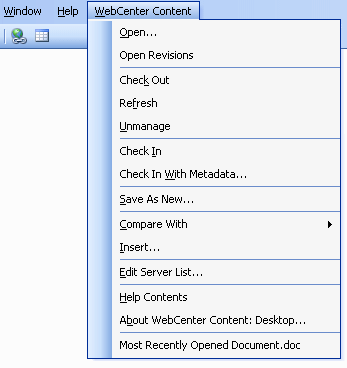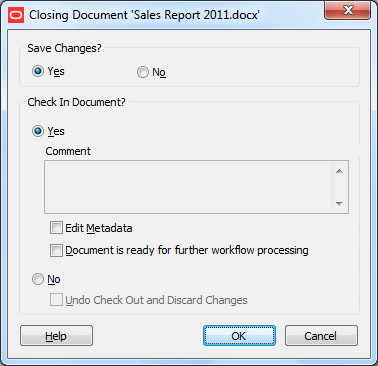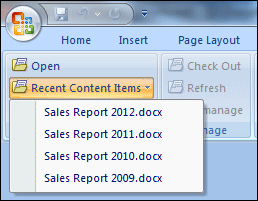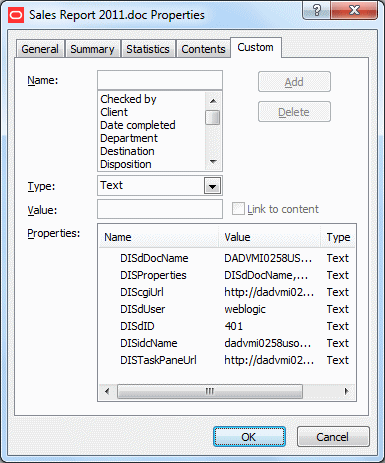| Oracle® WebCenter Content User's Guide for Desktop 11g Release 1 (11.1.1) Part Number E10624-04 |
|
|
PDF · Mobi · ePub |
| Oracle® WebCenter Content User's Guide for Desktop 11g Release 1 (11.1.1) Part Number E10624-04 |
|
|
PDF · Mobi · ePub |
This section covers these topics:
Section 4.2, "Integration Into Microsoft Office XP (2002) and 2003"
Section 4.3, "Integration Into Microsoft Office 2007 and 2010"
After installing the Desktop client software on your computer, you can interact with content servers and the files on them directly from a number of Microsoft Office applications. You can perform a number of content management tasks, including opening files from a content server ("check out"), saving file to a server ("check in"), searching for files on a server, comparing document revisions on a server, and inserting files on a server or links to these files into the current document.
Note:
Not all these features may be available in all Office applications and for all content servers (depending on their server type and version).The following Microsoft Office applications are supported:
Microsoft Word 2002 (XP) through 2010
Microsoft PowerPoint 2002 (XP) through 2010
Microsoft Excel 2002 (XP) through 2010
The Desktop client software adds a menu called WebCenter Content to the main Microsoft Office XP (2002) and 2003 application menu bars.
Figure 4-1 WebCenter Content menu in Microsoft Word 2003

The WebCenter Content menu contains the following menu items:
Open...: This option opens a dialog where you can locate a file on a content server and open it in the current Office application. The file is checked out of the content server. For more information, see Section 11.2, "Opening and Viewing an Existing Managed Document."
Open Revisions: This option opens a dialog where you can choose a particular revision of the managed file to be opened in the current Office application. For more information, see Section 11.5, "Opening a Different Revision of a Managed Document."
Check Out: This option checks the currently open read-only Office document out of the content server, so you can make changes and check it back in to the server as a new revision when you are done. For more information, see Section 11.4, "Checking Out a Managed Document in View Mode."
Refresh: This option updates the currently open managed Office document to the latest revision on Oracle WebCenter Content Server. For more information, see Section 11.6, "Refreshing a Managed Document."
Unmanage: This option removes the managed status of the current Office document and turns it into an unmanaged document, which means you can no longer check it in to the content server as a revision of the existing document. For more information, see Section 11.10, "Turning a Managed Document Into an Unmanaged Document."
Check In: This option checks the current Office document back in to the content server as a new revision using its existing metadata. (This option is available only if the current document is already managed by a content server.) For more information, see Section 11.8, "Saving and Checking In an Existing Managed Document."
Check In With Metadata...: This option opens a dialog where you can modify the metadata of the current Office document before checking it in to the content server as a new revision. (This option is available only if the current document is already managed by a content server.) For more information, see Section 11.8, "Saving and Checking In an Existing Managed Document."
Save As New...: This option opens a dialog where you can check the current Office document in to a content server as a new content item. For more information, see Section 11.7, "Creating and Checking In a New Managed Document."
Compare With: This option is available only in Microsoft Word. It enables you to compare the current Word document with another document:
Revision: This option enables you to compare the current Word document with a different revision of the same document on the content server. If you choose this option, a dialog is opened where you can select the document revision that you want to compare the current Word document with. (This option is available only if the current Word document is a managed content item.)
Content Item: This option enables you to compare the current Word document with a different document on the content server. If you choose this option, a dialog is opened where you can locate a file on the content server to compare to the document currently open in Microsoft Word.
For more information on the document comparison feature, see Section 11.12, "Comparing Managed Microsoft Word Documents."
Insert...: This option opens a dialog where you can select a file on a content server for insertion into the current Microsoft Word, Excel, or PowerPoint document (at the current cursor position). You can insert a hyperlink to a file on the server, the contents of a file, or an image. For more information, see Section 11.11, "Inserting Managed Content Into Office Documents."
Edit Server List...: This option opens a dialog where you can add, view, and delete server connections. For more information, see Chapter 7, "Working With Content Server Connections."
Help Contents: This option launches the Desktop online help in your standard web browser.
About WebCenter Content: Desktop...: This option opens a dialog that provides version information about the Desktop client software.
Most recently used (MRU) list: This lists a number of content items on Oracle WebCenter Content Server instances that were most recently opened in the Microsoft Office application. You can conveniently reopen a document by selecting it in the list. For more information, see Section 11.3, "Reopening a Recently Opened Managed Document."
The Desktop client software adds a ribbon called WebCenter Content to the Microsoft Office 2007 and 2010 application interfaces.
Figure 4-2 WebCenter Content Ribbon in Microsoft Word 2007

The WebCenter Content ribbon includes the following groups:
Open: This ribbon group contains the following option:
Open: This option opens a dialog where you can locate a file on a content server and open it in the current Office application. The file is checked out of the content server. For more information, see Section 11.2, "Opening and Viewing an Existing Managed Document."
Recent Content Items: This option opens a menu that lists a number of content items on Oracle WebCenter Content Server instances that were most recently opened in the Microsoft Office application. You can conveniently reopen a document by selecting it in the list. For more information, see Section 11.3, "Reopening a Recently Opened Managed Document."
Revisions: This option opens a dialog where you can choose a particular revision of the managed file to be opened in the current Office application. For more information, see Section 11.5, "Opening a Different Revision of a Managed Document."
Manage: This ribbon group contains the following options:
Check Out: This option checks the currently open read-only Office document out of the content server, so you can make changes and check it back in to the server as a new revision when you are done. For more information, see Section 11.4, "Checking Out a Managed Document in View Mode."
Refresh: This option updates the currently open managed Office document to the latest revision on Oracle WebCenter Content Server. For more information, see Section 11.6, "Refreshing a Managed Document."
Unmanage: This option removes the managed status of the current Office document and turns it into an unmanaged document, which means you can no longer check it in to the content server as a revision of the existing document. For more information, see Section 11.10, "Turning a Managed Document Into an Unmanaged Document."
Check In: This ribbon group contains the following options:
Check In: This option checks the current Office document back in to the content server as a new revision using its existing metadata. (This option is available only if the current document is already managed by a content server.) For more information, see Section 11.8, "Saving and Checking In an Existing Managed Document."
Check In With Metadata: This option opens a dialog where you can modify the metadata of the current Office document before checking it in to the content server as a new revision. (This option is available only if the current document is already managed by a content server.) For more information, see Section 11.8, "Saving and Checking In an Existing Managed Document."
Save As New: This ribbon group contains the following option:
Save As New: This option opens a dialog where you can check the current Office document in to a content server as a new content item. For more information, see Section 11.7, "Creating and Checking In a New Managed Document."
Compare: This ribbon group is available only in Microsoft Word. It contains the following options:
With Revision: This option enables you to compare the current Word document with a different revision of the same document on the content server. If you choose this option, a dialog is opened where you can select the document revision that you want to compare the current Word document with. (This option is available only if the current Word document is a managed content item.)
With Content Item: This option enables you to compare the current Word document with a different document on the content server. If you choose this option, a dialog is opened where you can locate a file on the content server to compare to the document currently open in Microsoft Word.
For more information on the document comparison feature, see Section 11.12, "Comparing Managed Microsoft Word Documents."
Insert: This ribbon group contains the following option:
Insert: This option opens a dialog where you can select one or more files on an Oracle WebCenter Content Server instance for insertion into the current Microsoft Word, Excel, or PowerPoint document (at the current cursor position). You can insert hyperlinks to files on a server, the contents of files, or images. For more information, see Section 11.11, "Inserting Managed Content Into Office Documents."
Misc: This ribbon group contains the following options:
Edit Server List: This option opens a dialog where you can add, view, and delete server connections. For more information, see Chapter 7, "Working With Content Server Connections."
Help Contents: This option launches the Desktop online help in your standard web browser.
About WebCenter Content: Desktop: This option opens a dialog that provides version information about the Desktop client software.
By default, when you have a checked-out document open in your Microsoft Office application and you close that document or the application, a special close dialog for managed documents opens (Figure 4-3).
Figure 4-3 Integration Close Dialog in Microsoft Office Application

This special close dialog enables you to decide what to do with the current checked-out document: you can save the changes (if there are any unsaved changes), check the document back in to the server as a new revision, add a comment, edit the document metadata before checking it in, not check it in and save it locally as an offline file, or cancel the checked-out status of the document. For more information, see Section 11.8.2, "Checking In a Managed Document When Closing It."
Note:
Optionally, you can configure Desktop to close managed documents in much the same way as unmanaged documents ("Do you want to save the changes?"), so you will not see this special dialog. See Section B.1, "Setting Windows Explorer Integration Options" ('Hide the Close Document check-in dialog' option).Microsoft Office applications provide a most recently used (MRU) list of content items on Oracle WebCenter Content Server instances that were opened in the application before. This enables you to quickly and conveniently reopen content items you worked on earlier.
Note:
The most-recently-used list only includes content items that reside on Oracle WebCenter Content Server or Oracle Content Server instances, not on Oracle Content Database servers or other WebDAV servers.In Office XP (2002) and 2003, the list is located at the bottom of the WebCenter Content menu. In Office 2007 and 2010, it is in the Recent Content Items dropdown menu in the WebCenter Content ribbon (Figure 4-4).
Figure 4-4 Most-Recently-Used (MRU) List in Microsoft Word 2007

The most recently opened file is at the top of the list. If you hover the mouse cursor over a list item in Office 2007 or 2010, you see the content ID of the file as well as the server it resides on. Tooltips are not provided in Office XP (2002) and 2003.
To reopen a recent content item, simply select it from the list, and it opens in the Office application. If the document was last opened in read-only mode ('view'), you are asked whether you want to open it in read-only mode again or if you want it opened in full edit mode ('open'). See Section 9.6, "Content Management Actions on Files" for a comparison between viewing and opening a file.
Changing the Maximum Number of MRU List Items
You can change the maximum number of items shown in the most recently used list:
Microsoft Office XP (2002) and 2003: Click Tools, then Options, open the General tab, and then set the maximum number of entries in the Recently used file list option. Make sure the check box for this option is selected.
Microsoft Office 2007: Click the Office button in the top left corner, then choose Word/Excel/PowerPoint Options, then Advanced, and then set the maximum number of entries in the Show this number of Recent Documents option.
Microsoft Office 2010: Open the File panel, then choose Options, then Advanced, and then set the maximum number of entries in the Show this number of Recent Documents option.
The new setting takes effect as soon as you close the options dialog, but the number of items shown on the list will not change until a new document is added to it.
A number of custom properties may be added to Microsoft Office files, depending on the content server type and configuration (specifically, the DesktopTag feature on Oracle WebCenter Content Server). By default, these new custom properties include:
DISdDocName: This is the content ID of the document on the content server. Every content item on the server has its own content ID, which uniquely identifies that item on the server. (Please note that each checked-in document revision has an additional, internal ID as a unique reference to that specific revision; see DISdID below.)
DISProperties: This is a list of all Desktop properties that are added to Microsoft Office documents.
DIScgiUrl: This is the CGI URL of the content server that the document resides on. It essentially enables Office applications (or other third-party software) to "remember" what content server the Office document came from when it was opened in the application, and where it was stored on the server.
DISdWorkflowState: This is the current state of the document in a workflow (if applicable).
DISdUser: This is the user name of the document author (or more specifically, the user who checked the document in to the content server).
DISdID: This is the unique identifier for this specific document revision on the content server. Every revision of a content item on the server has its own internal ID, which provides a unique reference to that specific revision of the content item.
DISTaskPaneUrl: This is the URL that can be used to display information about the content item in the task pane of Microsoft Office applications (or other third-party software).
Note:
The custom properties are automatically handled by Desktop and should not be changed by end users.Viewing the Custom Properties
You can view the custom properties of a Microsoft Office file as follows:
Microsoft Office XP (2002) and 2003: Choose File, then Properties, and then open the Custom tab.
Microsoft Office 2007: Click the Office button in the top left corner, then choose Prepare, then Properties, then Document Properties, then Advanced Properties, and then open the Custom tab.
Microsoft Office 2010: Open the File panel, then click Info, then Properties, then Advanced Properties, and then open the Custom tab.
Figure 4-5 Custom Document Properties (Microsoft Word 2007)

These custom document properties allow Desktop to keep track of the location of a managed Office document on a content server as well as its revision history. This enables users to open the most recent revision of a managed document even if they have an older revision, or to check a document back in to a content server even outside a content management integration context. This may be useful in a number of situations, for example:
You received a managed Office document from someone else, for example as an attachment to an e-mail.
You received a managed Office document that may not be the most recent revision.
You copied a managed Word document from a server in the integration hierarchy on your computer to a folder outside that hierarchy.
In any of these cases, you can open the latest revision of the document in Microsoft Word on your computer, make changes, and then check it back in to the server using the WebCenter Content menu or ribbon in Word. Desktop looks at the custom properties embedded in the Word document to find out where to upload the file to.